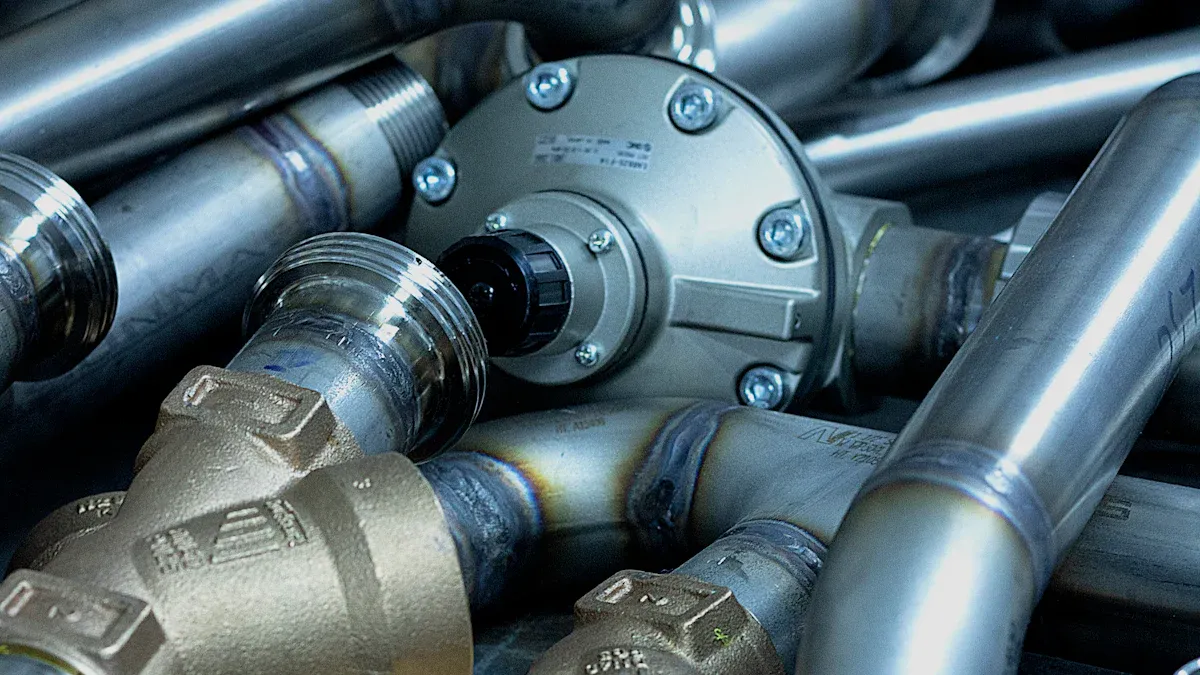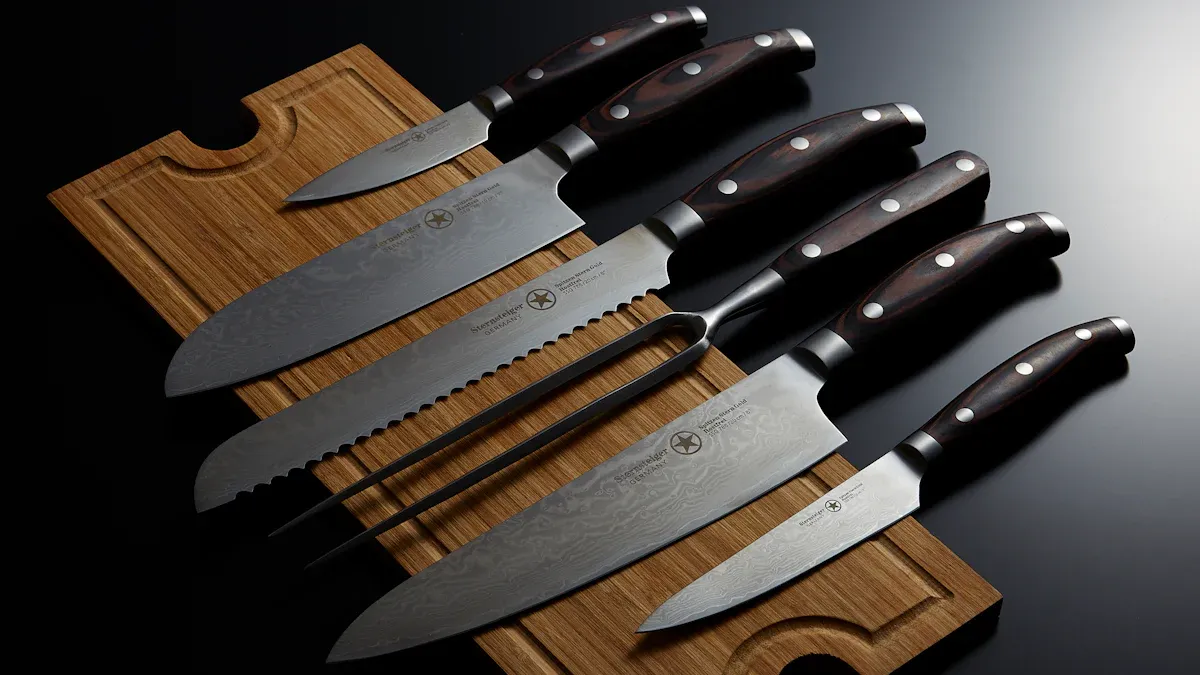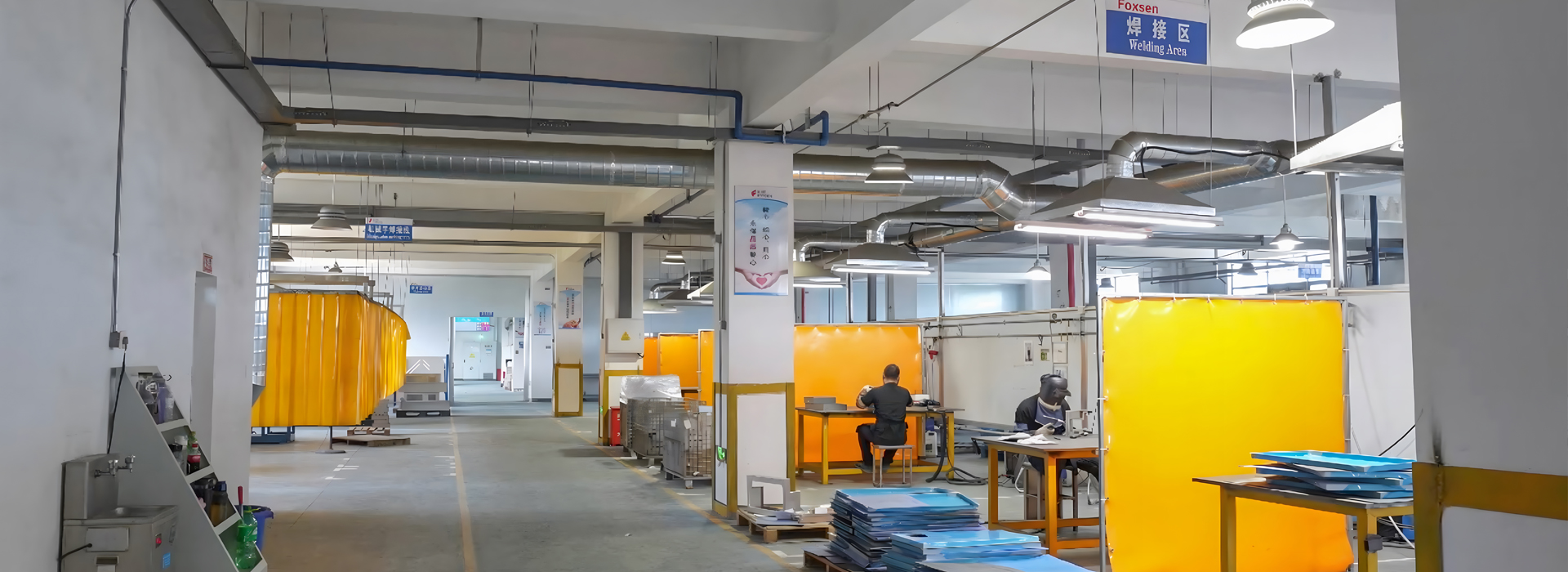Stainless steel stands out as one of the most versatile and durable materials in modern industries. It’s a corrosion-resistant alloy primarily made of iron, chromium, and other elements like nickel or molybdenum. This unique composition gives stainless steel its remarkable ability to resist rust and staining, even in harsh environments.
Recent research has highlighted how chromium content directly impacts corrosion resistance. Studies reveal:
High chromium levels in 316 stainless steel improve pitting resistance.
A balanced Cr/Ni ratio ensures a uniform microstructure for better performance.
Ultra-high chromium concentrations may even replace molybdenum in specific applications.
Stainless Steel Metal Products come in various classifications, each tailored to specific needs. From austenitic to martensitic types, these variations offer a range of strengths, corrosion resistance, and applications.
Key Takeaways
Stainless steel is strong and useful for many industries. It resists rust because it contains chromium.
Austenitic stainless steel is the most popular type. It resists rust well and bends easily. It is great for kitchen tools and medical devices.
Ferritic stainless steel is cheaper but still resists rust. It is often used in cars and buildings.
Martensitic stainless steel is very strong and hard. It works well for tools and airplane parts.
Picking the right stainless steel depends on what you need. Think about rust resistance, strength, and cost.
Main Types of Stainless Steel Metal Products

Stainless steel metal products are categorized into distinct types based on their alloy composition and unique properties. These classifications help industries select the right material for specific applications. Let me walk you through three of the most prominent types: Austenitic, Ferritic, and Martensitic stainless steel.
Austenitic Stainless Steel
Austenitic stainless steel is the most widely used type, known for its exceptional corrosion resistance and high ductility. Its composition typically includes high levels of chromium and nickel, which contribute to its non-magnetic nature and ability to withstand extreme temperatures.
Fun Fact: Austenitic stainless steel accounts for over 70% of global stainless steel production, making it the backbone of many industries.
Here’s a closer look at its performance characteristics:
Its versatility makes it ideal for applications such as kitchenware, medical instruments, and structural components in engineering. For instance, its excellent seismic performance has proven invaluable in earthquake-prone regions.
Ferritic Stainless Steel
Ferritic stainless steel offers a cost-effective alternative to austenitic grades while maintaining impressive corrosion resistance. It contains lower nickel levels, making it more affordable and suitable for applications requiring moderate durability.
I’ve noticed that ferritic stainless steel shines in industries like automotive and construction. It’s commonly used in exhaust systems, fuel lines, and roofing materials.
Here are some of its standout features:
Corrosion Resistance: Comparable to austenitic grades, with specific advantages in certain environments.
Thermal Conductivity: Excellent heat transfer capabilities, ideal for heat exchangers.
Cost-Effectiveness: Lower cost than austenitic stainless steels.
Fabrication Ease: Less prone to springback during cold forming.
Tip: If you’re looking for a stainless steel type that balances performance and affordability, ferritic stainless steel is a great choice.
Martensitic Stainless Steel
Martensitic stainless steel is the go-to option for applications requiring high strength and hardness. Unlike austenitic and ferritic types, it contains higher carbon levels, which enhance its mechanical properties.
This type is widely used in tools, knives, and turbine blades due to its ability to withstand wear and tear. Studies have shown remarkable improvements in its yield strength and durability:
Martensitic stainless steel’s strength and durability make it indispensable in industries like aerospace and engineering.
Duplex Stainless Steel
Duplex stainless steel combines the best features of austenitic and ferritic stainless steels, creating a hybrid material with remarkable properties. I’ve always admired its ability to balance strength and corrosion resistance, making it a favorite in demanding industries.
Here’s why duplex stainless steel stands out:
It has high chromium and molybdenum content, which boosts its resistance to chloride-induced corrosion, including pitting and crevice corrosion. This makes it ideal for marine, offshore, and chemical processing applications.
Its 0.2% proof strength ranges from about 450 MPa to over 550 MPa for super duplex grades. This high strength allows for thinner and lighter components, saving both material and weight.
Duplex stainless steels reduce maintenance needs, increasing industrial efficiency.
I’ve seen duplex stainless steel used in oil rigs, desalination plants, and bridges. Its ability to withstand harsh conditions ensures long-term reliability.
Tip: If you need stainless steel metal products for environments with high chloride exposure, duplex stainless steel is a smart choice.
Precipitation-Hardening Stainless Steel
Precipitation-hardening stainless steel (PHSS) is a marvel of engineering. It combines excellent mechanical strength with impressive corrosion resistance, thanks to its unique composition and microstructure.
I find PHSS particularly fascinating because of its aging heat treatment process. Aging at 480 °C significantly improves its anti-corrosion properties, especially in dilute sulfuric acid environments. This makes it a go-to material for chemical processing and aerospace applications.
Here’s a breakdown of research findings on PHSS:
I’ve noticed PHSS being used in turbine blades, gears, and high-performance tools. Its ability to maintain strength under extreme conditions makes it indispensable in industries requiring precision and durability.
Note: For applications requiring both high strength and corrosion resistance, precipitation-hardening stainless steel is an excellent choice.
Properties and Applications of Stainless Steel

Corrosion Resistance and Strength
Stainless steel’s ability to resist corrosion is one of its most remarkable features. I’ve seen firsthand how industries rely on this property to ensure durability in challenging environments. Chromium plays a key role here. It forms a thin, protective oxide layer on the surface, shielding the metal from rust and degradation.
In experimental studies, stainless steel grades like AISI 316L and 304L demonstrated impressive corrosion resistance. When exposed to molten salt at 600 °C, their corrosion rates remained low, though they varied with temperature and time. Molybdenum and chromium concentrations further enhanced this resistance. For example, DS2507 stainless steel showed minimal thickness loss compared to SS301 and DS2205 in molten carbonate sodium salts.
Strength is another defining characteristic of stainless steel. Its ability to maintain mechanical integrity under stress makes it indispensable in construction and engineering. I’ve noticed that stainless steel metal products, such as beams and supports, are often used in earthquake-resistant structures due to their high yield strength and ductility.
Tip: For environments with high temperatures or corrosive substances, stainless steel grades like AISI 316 are ideal choices.
Magnetic and Non-Magnetic Properties
One fascinating aspect of stainless steel is its magnetic behavior. Some types are magnetic, while others are not. This difference stems from their crystal structures.
Austenitic stainless steel, such as 304 and 316 grades, is non-magnetic due to its FCC crystal structure. This makes it ideal for applications requiring high corrosion resistance and ductility. On the other hand, ferritic and martensitic stainless steels exhibit magnetic properties due to their BCC and BCT structures. These types are often used in electromagnetic applications, such as solenoids and electric motors.
I’ve found that understanding these differences helps industries choose the right stainless steel for specific needs. For example, non-magnetic stainless steel is preferred in medical imaging equipment, while magnetic types are used in automotive components.
Common Applications Across Industries
Stainless steel’s versatility makes it a cornerstone material across industries. I’ve seen its applications range from everyday household items to advanced aerospace components.
In construction, stainless steel is used for structural supports, roofing, and cladding due to its strength and corrosion resistance.
In the automotive industry, it’s found in exhaust systems, fuel tanks, and decorative trims. Its durability ensures long-term performance.
In healthcare, stainless steel is indispensable for surgical instruments, implants, and hospital equipment. Its non-reactive nature makes it safe for medical use.
In food processing, stainless steel is used for storage tanks, conveyor belts, and kitchenware. Its hygienic properties prevent contamination.
In energy production, stainless steel is used in turbines, pipelines, and nuclear reactors. Its ability to withstand extreme conditions ensures reliability.
The global stainless steel market continues to grow, driven by rising demand in these industries. Western Europe leads the way, thanks to its advanced infrastructure and industrial base. I’ve noticed that technological innovations, such as improved alloy compositions, are further expanding stainless steel’s applications.
Note: Stainless steel’s adaptability makes it a valuable material for industries seeking durability, hygiene, and performance.
Additional Classifications of Stainless Steel
Stainless Steel Grades (e.g., 304, 316, 430)
Stainless steel grades play a crucial role in determining the performance and suitability of stainless steel metal products for specific applications. I’ve noticed that grades like 304, 316, and 430 dominate the market due to their unique properties.
Grade 304 is the most common type. It offers excellent corrosion resistance and durability, making it ideal for kitchen utensils like pots and pans. Grade 316, on the other hand, stands out for its superior mechanical properties and resistance to wear. I often recommend it for high-wear applications such as knives and marine equipment. Grade 430 provides a cost-effective option with moderate corrosion resistance, often used in decorative trims and appliances.
Here’s a quick comparison of these grades:
304: High durability, suitable for kitchenware.
316: Superior wear resistance, ideal for knives and marine environments.
430: Affordable, used in decorative applications.
Interestingly, research shows that the end-user segment accounted for 65% of the global stainless steel bar market revenue in 2023. This highlights the importance of selecting the right grade for specific needs.
Surface Finishes of Stainless Steel Metal Products
Surface finishes significantly impact the aesthetics and durability of stainless steel. I’ve found that choosing the right finish can optimize both performance and appearance.
Two common finishes are the 2B finish and the No. 4 finish. The 2B finish is smooth and moderately reflective, making it perfect for industrial applications where corrosion resistance is key. The No. 4 finish, with its dull grain pattern, is more aesthetically appealing and often used in high-traffic areas like elevators and countertops.
Selecting the right finish depends on factors like environmental conditions and maintenance needs. For example, I often recommend the 2B finish for chemical processing equipment and the No. 4 finish for architectural projects.
Heat Treatment and Processing Methods
Heat treatment transforms the mechanical properties of stainless steel, making it suitable for diverse applications. I’ve seen how techniques like annealing and aging improve strength and durability.
Studies show that annealed samples develop coarser martensite laths, reducing hardness values. Aging, on the other hand, leads to the formation of nano-metric Cu-rich precipitates, which strengthen the matrix. For instance, precipitation-hardening stainless steel benefits from aging treatments that enhance tensile strength and fatigue life.
I’ve noticed that solution annealing produces a uniform matrix, while aging creates dispersion hardening effects. These methods are essential for industries like aerospace and automotive, where precision and durability are critical.
How to Choose the Right Stainless Steel
Key Factors to Consider
Choosing the right stainless steel requires careful evaluation of several factors. I always start by considering the environment where the material will be used. For example, exposure to moisture, chemicals, or extreme temperatures can significantly impact performance. Chromium concentration plays a vital role in corrosion resistance. Proper estimation of chromium levels ensures durability without the need for costly re-balancing procedures.
Energy efficiency during production is another key factor. Innovative strategies, such as refining methods like degassing and inert gas bubbling, improve product quality by removing impurities. These techniques also enhance cost-efficiency. Optimizing raw materials, like alloy compositions, can further improve performance while reducing expenses.
Comparing Types for Specific Applications
Each type of stainless steel offers unique advantages and limitations. I often use an analytical framework to guide my selection process. For instance, austenitic stainless steel is ideal for food and pharmaceutical industries due to its exceptional corrosion resistance. Ferritic stainless steel, with its lower cost and good thermal conductivity, works well in automotive and household appliances. Martensitic stainless steel, known for its hardness and strength, suits moderate environments like tool manufacturing.
Expert Tips for Selection
When selecting stainless steel, I recommend focusing on the specific requirements of your application. For environments with high chloride exposure, duplex stainless steel offers excellent resistance to pitting and crevice corrosion. For high-strength needs, precipitation-hardening stainless steel is a reliable choice.
I also advise considering long-term performance. Studies show that stainless steel rebars outperform ordinary rebars in corrosion resistance and static performance. They also provide better ductility and energy dissipation, making them ideal for reinforced concrete in construction.
Tip: Always consult with experts or refer to industry standards to ensure you select the most suitable stainless steel for your project. This approach minimizes risks and maximizes efficiency.
Stainless steel classifications offer unique properties tailored to diverse applications. Austenitic types excel in corrosion resistance, while martensitic grades provide unmatched strength. Duplex stainless steel balances durability and cost-effectiveness. Selecting the right type ensures optimal performance and longevity.
Industry surveys highlight key properties like fatigue resistance and ion release as critical factors for material selection:
I always recommend consulting experts or industry standards to ensure the best choice for your needs.
FAQ
What is stainless and heat resisting steel?
Stainless and heat resisting steel refers to alloys designed to withstand high temperatures and resist corrosion. I often recommend these materials for applications like turbines, heat exchangers, and chemical processing equipment due to their durability and performance under extreme conditions.
How does the ASTM designation system classify stainless steel?
The ASTM designation system categorizes stainless steel based on its chemical composition and mechanical properties. I find this system helpful for identifying grades like 304 and 316, ensuring the right material is chosen for specific industrial applications.
Can stainless steel be magnetic?
Yes, some types of stainless steel, like ferritic and martensitic grades, are magnetic. Their crystal structures determine this property. I usually suggest non-magnetic austenitic stainless steel for environments requiring high corrosion resistance.
What are the benefits of duplex stainless steel?
Duplex stainless steel combines strength and corrosion resistance. Its high chromium and molybdenum content make it ideal for marine and chemical industries. I’ve seen it reduce maintenance costs while improving efficiency in harsh environments.
How do surface finishes impact stainless steel performance?
Surface finishes affect both aesthetics and durability. For industrial use, I recommend the 2B finish for corrosion resistance. For decorative applications, the No. 4 finish offers a visually appealing grain pattern.






